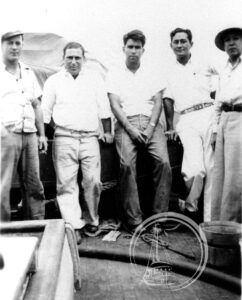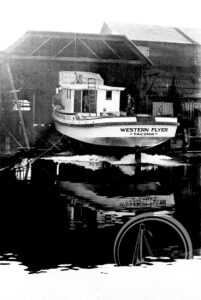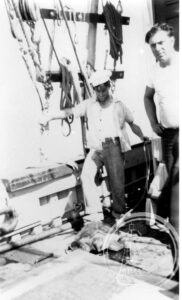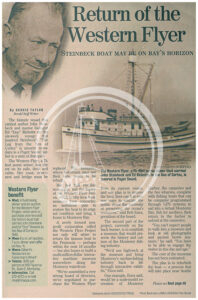

In March of 1940, marine ecology in the Gulf of California (also known as the Sea of Cortez) was born with the pioneering expedition of Ed Ricketts and John Steinbeck aboard the Western Flyer, a sardine seiner out of Monterey, California. Although biologists had visited the area earlier, none had done so using a holistic ecological approach, thoroughly surveying the local fauna or littoral communities.
Steinbeck and Ricketts chronicled their voyage in Sea of Cortez: A Leisurely Journal of Travel and Research (Viking Press, 1941). The book is an essay on the then-emerging field of ecology, a travelogue, an adventure story, and a philosophical inquiry. During their six-week voyage, Steinbeck and Ricketts made 24 discrete collections from 21 localities. They captured thousands of specimens and over 560 species of marine invertebrates, and the synoptic catalog in Sea of Cortez was the first-ever compendium of the invertebrate fauna of the Gulf of California. Only 484 species of invertebrates are listed in the book’s phyletic catalog, but many more were collected and later identified by specialists from around the world. About 40 new, then-undescribed species were also taken on the journey, most of which have since been named.

The landmark voyage and book had a profound impact on Ricketts and Steinbeck—and, ultimately, on the American environmental consciousness. The book was the first public call for conservation in the region, and it brought an awareness of the Gulf of California to both the public and scientific worlds. In the years since publication, the chronicle of the expedition has inspired hundreds—perhaps thousands—of young students to devote their careers to marine and field biology.
In 1923, Ricketts and his wife, Anna (Nan) Maker moved from Chicago to Monterey. There, Ed and his partner Albert Galigher started the Pacific Biological Laboratory, which supplied biological specimens to schools and laboratories around the country. Though environmentalism as we know it today did not exist in the 1920s and 1930s, and the field of ecology itself was still an obscure scientific discipline, as Ricketts collected tidepool animals for his business from Alaska to Mexico, an emerging sense of community began to permeate his thinking. Ricketts’s observations and ideas grew into his 1939 book, Between Pacific Tides, which used emerging ecological principles to describe how environmental conditions might predict the presence of species and how communities of organisms could function as wholes. Writing with an understanding of food webs new to most biologists of the time, Ricketts helped to pioneer the concept of community ecology. Although he did not discover the phenomenon of intertidal zonation, Ricketts was the first person to codify the concept for a broad region and to integrate it with a modern view of community ecology. His book would become a pivotal environmental text, with five editions to date.

Like Ricketts, Steinbeck never finished college, both men preferring a more unstructured and experiential approach to learning. But his strong fascination with the sea helped bring him to Pacific Grove in 1929, where he planned to sit out the Great Depression in his father’s cottage. When Steinbeck and Ricketts met in 1930 at the respective ages of 28 and 33, they struck up a friendship based on their shared passion for marine biology, literature, and philosophy.
Though now considered perhaps Steinbeck’s greatest book, when first published in 1939, The Grapes of Wrath ignited a storm of controversy, with California’s powerful and conservative agricultural community reacting violently. Branding Steinbeck a communist, they condemned him for his harsh (though realistic) portrayal of agribusiness farms and their horrible treatment of migrant workers, leading to death threats, accusations of being a “drug fiend,” and book burnings across the nation, as well as an investigation by J. Edgar Hoover’s FBI. The public reaction so stunned Steinbeck that in the spring of 1939, on the brink of despair, he declared an end to his career as a novelist.

At that moment, Ed Ricketts and the Sea of Cortez provided a path for Steinbeck to remove himself physically and intellectually from the conflicts that had come to haunt him as a novelist. In the opening chapter of Sea of Cortez, the friends later wrote of their intention to “go into the Sea of Cortez, realizing that we become forever a part of it; that our rubber boots slogging through a flat of eel-grass, that the rocks we turn over in a tide pool, make us truly and permanently a factor in the ecology of the region.” They were fascinated by the chance to enter an unfamiliar ecological system: “We shall take something away from it, but we shall leave something too. And if we seem a small factor in a huge pattern, nevertheless it is of relative importance. We take a tiny colony of soft corals from a rock in a little water world. And that isn’t terribly important to the tide pool. Fifty miles away the Japanese shrimp boats are dredging with overlapping scoops, bringing up tons of shrimps, rapidly destroying the species so that it may never come back, and with the species destroying the ecological balance of the whole region. That isn’t very important in the world. And thousands of miles away the great bombs are falling and the stars are not moved thereby. None of it is important or all of it is.”
That ecological perspective would inform the entire voyage and their account of it. On April 9, 1940, the Flyer encountered a fleet of 11 Japanese trawlers and a factory ship working the seafloor near Guaymas for shrimp. Steinbeck and Ricketts observed those destructive fishing practices closely, noting, “they were doing a very systematic job, not only of taking every shrimp from the bottom, but every other living thing as well. They cruised slowly along in echelon with overlapping dredges, literally scraping the bottom clean.” And “The waste . . . was appalling.” Their holistic vision allowed Ricketts and Steinbeck to recognize shrimp trawling as an ecologically damaging and wasteful form of fishing. (Lacking such perspective, the Mexican government soon kicked out the Japanese ships—and ramped up their own shrimp fishing fleets, thereby expanding the destruction of the Sea of Cortez seafloor.)

The goal of the Ricketts-Steinbeck expedition was not to see how many species they could find nor how many undescribed species they might discover (though they discovered many). It was for something larger—to attain an overall sense of the fauna, its ecological relationships to other regions, and a view of a whole interconnected ecosystem of the Sea of Cortez, much as Ricketts had already done on the U.S. Pacific Coast. And beyond the science and the geography, the expedition nourished a holistic view of the world that came to steer the writings of both men (Ricketts himself would serve as a model for characters in eight of Steinbeck’s novels, with the latter overcoming the outcry over The Grapes of Wrath to win the Presidential Medal of Freedom, a Pulitzer Prize, and a Nobel Prize for Literature). As they noted, “ . . . all things are one thing and that one thing is all things—plankton, a shimmering phosphorescence on the sea, and the spinning planets and an expanding universe, all bound together by the elastic string of time. It is advisable to look from the tide pool to the stars and then back to the tide pool again.”
Richard C. Brusca
Research Scientist, University of Arizona, Tucson
and
Emeritus Executive Director, Arizona-Sonora Desert Museum
